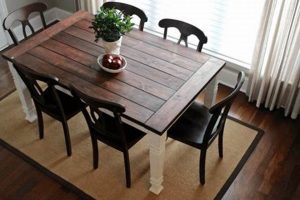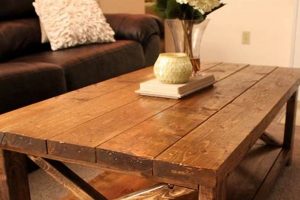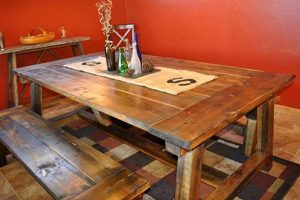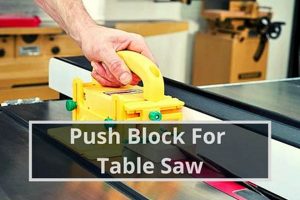A user-constructed platform designed to enhance the functionality of a table saw represents a practical solution for improving woodworking precision and safety. These custom-built accessories provide increased surface area, improved dust collection capabilities, and integrated features for more controlled cuts. For example, a craftsman might build one with adjustable fences and miter slots to accommodate varied project requirements.
Such an addition offers several key advantages. It allows for the creation of larger, more stable work surfaces, enabling the handling of larger material pieces. The inclusion of integrated dust collection systems significantly reduces airborne particles, promoting a healthier work environment. Historically, woodworkers have adapted their tools and workspaces to optimize performance; these homemade platforms are a continuation of that tradition, reflecting a resourcefulness driven by both economic factors and a desire for tailored solutions.
The subsequent sections will detail various construction methods, material selections, essential features, and safety considerations involved in creating an effective platform to support a table saw.
Construction Recommendations
The following guidelines are intended to optimize the build process and ensure a durable, functional, and safe apparatus.
Tip 1: Prioritize a Stable Foundation: Employ a robust frame, typically constructed from 2×4 lumber or steel, to minimize vibration and ensure consistent cutting performance. Reinforce joints with screws and glue for added structural integrity.
Tip 2: Implement a Flat and Durable Surface: Select a high-density material like MDF (Medium-Density Fiberboard) or plywood for the tabletop surface. Ensure it is perfectly flat and securely attached to the frame to prevent workpiece slippage. Consider applying a laminate or sealant for moisture resistance and ease of cleaning.
Tip 3: Integrate an Accurate Fence System: Install a rigid and adjustable fence system, either commercially available or custom-built, to ensure accurate and repeatable cuts. The fence should lock securely in place and feature a micro-adjustment mechanism for fine-tuning. Regularly calibrate the fence to maintain precision.
Tip 4: Incorporate Effective Dust Collection: Design a dust collection system that connects directly to the saw’s dust port and integrates with a shop vacuum or dust collector. Enclose the underside of the table as much as possible to maximize dust capture. This improves visibility and reduces respiratory hazards.
Tip 5: Include Miter Slots for Versatility: Integrate standard-sized miter slots into the tabletop to accommodate miter gauges and sliding jigs. Ensure the slots are parallel to the saw blade for accurate angled cuts. Consider using t-track for greater versatility in jig placement.
Tip 6: Add Outfeed and Infeed Support: Construct outfeed and infeed supports to provide additional workpiece support, particularly when cutting long or heavy materials. Folding or adjustable supports offer flexibility and space-saving options.
Tip 7: Prioritize Safety Features: Integrate safety features such as a power switch easily accessible and located away from the blade. Ensure adequate lighting to provide clear visibility of the cutting area. Consider adding a blade guard and anti-kickback pawls if the existing table saw setup lacks them.
Adhering to these recommendations will result in a safer, more efficient, and more versatile woodworking setup. Attention to detail during the design and construction phases is paramount for achieving optimal results.
The subsequent section will discuss potential drawbacks to consider.
1. Enhanced Safety
The construction of a user-built platform for a table saw directly correlates with improved operator safety. A primary safety enhancement stems from the increased stability afforded by a well-designed platform. Factory-supplied stands are often minimal, resulting in potential instability, particularly when working with large or heavy stock. A custom platform, constructed from robust materials and featuring a wider footprint, mitigates the risk of the saw tipping or shifting during operation. This stability allows the operator to maintain better control over the workpiece, reducing the likelihood of kickback or other dangerous occurrences. An example is the inclusion of a broad, level outfeed support that prevents long boards from sagging, a common cause of binding and subsequent kickback.
Furthermore, a platform facilitates the integration of enhanced dust collection systems. Controlling sawdust is crucial for respiratory health and improved visibility of the cut line. A user-constructed table provides the opportunity to enclose the area beneath the saw, creating a more effective dust collection chamber. This contrasts with open-legged factory stands that offer minimal dust control. Another safety-related feature often incorporated is a dedicated, easily accessible power switch. This allows the operator to quickly shut down the saw in an emergency without having to reach for the saw’s original switch, which may be inconveniently located. The ability to place the switch prominently on the platform contributes significantly to reaction time in critical situations.
In summary, a carefully designed platform provides a safer woodworking experience by improving stability, enhancing dust control, and facilitating the integration of emergency shut-off mechanisms. The practical significance lies in reducing the risk of accidents, promoting a healthier working environment, and ultimately, contributing to a higher level of confidence and control during table saw operation. Neglecting these safety considerations when using a table saw, even with a platform, can negate the intended benefits. Regular inspection and maintenance of the platform and saw are also essential.
2. Improved Accuracy
The correlation between a self-constructed platform for a table saw and enhanced cutting precision is significant. A primary cause of inaccuracies in table saw operation stems from vibrations and instability inherent in factory-supplied stands. These stands often lack the mass and rigidity required to dampen vibrations generated by the saw motor and blade. A well-designed user-built platform, conversely, can be engineered for substantial stability, often incorporating a heavier frame and a solid, flat tabletop. This increased stability directly translates to reduced blade wobble and minimized material movement during the cut, resulting in cleaner, more accurate results. The importance of this improved accuracy is paramount in projects demanding tight tolerances, such as cabinet making or intricate joinery. For example, a cabinetmaker might construct a platform with integrated, precisely aligned miter slots to ensure perfectly square cuts for cabinet components, a level of precision difficult to achieve with a less stable setup.
Furthermore, a custom platform provides the opportunity to integrate advanced fence systems that contribute to accuracy. Standard fences may exhibit deflection under pressure, leading to inconsistent cut widths. A user-built platform can accommodate a robust, precisely aligned fence with minimal deflection, often incorporating micro-adjustment mechanisms for fine-tuning. This allows for highly accurate repeatable cuts, essential for projects involving multiple identical pieces. Consider a scenario where a craftsman is building a set of identical shelves. Using a platform with a high-quality fence ensures that each shelf is cut to the exact same width, eliminating the need for time-consuming adjustments and ensuring a professional-looking finished product. The ability to create jigs and fixtures tailored to specific tasks further enhances accuracy. These can be easily mounted and secured to a user-built platform, providing additional control and support for complex cuts.
In summary, improved accuracy is a critical benefit derived from constructing a platform for a table saw. This improvement stems from enhanced stability, the integration of superior fence systems, and the capacity to create custom jigs and fixtures. The practical significance lies in achieving tighter tolerances, reducing material waste, and producing higher-quality finished products. However, it is crucial to acknowledge that achieving improved accuracy requires careful planning, precise construction, and a thorough understanding of table saw operation and safety procedures. Neglecting any of these aspects can negate the potential benefits and even introduce new sources of error.
3. Optimized Workspace
The implementation of a user-constructed platform to support a table saw directly influences the optimization of workspace within a woodworking environment. A factory-supplied stand for a table saw often provides minimal surface area, limiting the ability to efficiently manage materials and tools during operation. Constructing a platform, however, allows for a customizable work area tailored to specific project requirements. The immediate impact is an increased usable surface around the saw blade, which provides enhanced support for larger workpieces, facilitating smoother and safer cuts. The inclusion of features such as integrated storage for blades, push sticks, and other accessories further streamlines workflow by keeping essential items within easy reach. For instance, a woodworker engaged in constructing a large cabinet might design a platform with built-in drawers for hardware and a designated area for clamps, thus minimizing time spent searching for tools and maximizing productive work time.
Furthermore, a thoughtfully designed platform enables the incorporation of outfeed and infeed supports, effectively extending the usable workspace and providing critical support for long or unwieldy materials. This is particularly crucial when cutting large panels or boards, as unsupported material can lead to binding, kickback, or inaccurate cuts. Folding or retractable supports offer additional flexibility, allowing the workspace to be adapted as needed. Another practical application involves integrating a dust collection system directly into the platform. Enclosing the area beneath the saw and connecting it to a dust collector significantly reduces airborne particles, improving air quality and minimizing cleanup time. This not only contributes to a healthier and more pleasant work environment but also frees up valuable time that would otherwise be spent on dust removal.
In summary, a user-built platform for a table saw is intrinsically linked to workspace optimization. By providing increased surface area, integrated storage, enhanced material support, and effective dust collection, it fosters a more efficient, safer, and more productive woodworking environment. The degree of optimization is directly proportional to the level of planning and attention to detail incorporated into the platform’s design. While the benefits are substantial, challenges may arise in terms of initial construction time and potential space limitations. The overall theme underscores the value of proactively adapting tools and workspaces to enhance performance and improve the quality of woodworking projects.
4. Cost-Effectiveness
The economic advantage associated with a self-constructed platform for a table saw stems from the potential for significant cost savings compared to purchasing commercially manufactured alternatives. Factory-produced table saw tables, particularly those with advanced features like integrated dust collection or precision fence systems, can represent a substantial capital expenditure. By opting for a user-built solution, resources are channeled towards materials and components, often sourced at a lower cost than the aggregated price of a pre-fabricated unit. Furthermore, a user-designed platform permits the selective incorporation of features based on individual needs and budget constraints, avoiding the expense of extraneous functionalities included in commercially available models. An example is a craftsman repurposing reclaimed lumber for the frame, thereby reducing material costs substantially, while still achieving a structurally sound and functional platform. This ability to tailor the design and utilize cost-effective materials is a primary driver of the economic benefit.
Another contributing factor to the cost-effectiveness of a self-built table saw platform lies in the reduction of indirect expenses. A custom-built platform can be designed to integrate seamlessly with existing shop equipment and workflows, minimizing the need for additional modifications or accessories. For instance, a platform could be constructed to match the height of adjacent workbenches, creating a unified and ergonomic workspace, eliminating the need for separate leveling adjustments or specialized material handling solutions. In addition, the process of constructing the platform itself can be viewed as an investment in skill development and tool proficiency, enhancing the craftsman’s capabilities and potentially leading to further cost savings in future projects. A homeowner building their own table saw table may also increase their home value.
In conclusion, the cost-effectiveness of constructing a table saw platform is a multifaceted benefit derived from reduced material costs, customized functionality, and the avoidance of ancillary expenses. The practical implications extend to both professional woodworkers seeking to optimize their operational budget and hobbyists aiming to equip their workshops without incurring excessive costs. It should be noted that accurate cost assessment, encompassing material procurement, construction time, and potential tooling expenses, is crucial for realizing the full economic advantage. While challenges may arise in terms of design complexity or the initial investment in necessary tools, the potential for long-term cost savings and enhanced workshop efficiency underscores the value of this approach.
5. Customized Functionality
The inherent adaptability of a user-constructed platform for a table saw is directly linked to the concept of customized functionality. Unlike commercially produced stands, these platforms offer the opportunity to integrate specific features and modifications tailored to individual woodworking needs and project requirements.
- Integrated Dust Collection Systems
User-designed platforms enable the incorporation of dust collection systems specifically optimized for the saw and the workshop environment. This may involve enclosing the underside of the table, incorporating baffles to direct airflow, or customizing the port size to match existing dust collection equipment. For example, a woodworker frequently cutting hardwoods might design a system with a higher-capacity dust collector and specialized ductwork to effectively capture fine dust particles, minimizing respiratory hazards and maintaining a cleaner workspace.
- Adjustable Fence and Miter Systems
Factory-supplied fences often lack the precision and adjustability required for demanding woodworking tasks. A user-built platform allows for the integration of aftermarket fence systems with micro-adjustment capabilities or the construction of custom fences tailored to specific cutting operations. Similarly, miter slots can be precisely aligned and sized to accommodate various miter gauges and sliding jigs, enhancing accuracy and versatility. A furniture maker, for instance, might construct a platform with a long, heavy-duty fence and a precision miter gauge to ensure accurate and repeatable angled cuts for chair legs and other intricate components.
- Integrated Storage Solutions
The platform can be designed to incorporate storage compartments for blades, jigs, push sticks, and other accessories, keeping essential items within easy reach and minimizing clutter. This might involve adding drawers, shelves, or dedicated racks for specific tools. A craftsman specializing in small projects, such as jewelry boxes or turned items, might design a platform with multiple small drawers to organize various cutting tools and measuring devices.
- Variable Height and Mobility Options
A user-built platform can be customized to match the user’s height and workspace configuration, promoting ergonomic comfort and reducing fatigue. This can involve constructing a platform with adjustable legs or integrating a mobile base for easy repositioning within the shop. A woodworker with limited space might design a platform with folding wings and locking casters to maximize workspace when the saw is in use and minimize its footprint when stored.
These customizable aspects of the platform allow for optimizing efficiency, safety, and precision, providing a workflow uniquely fitted to the user’s skill level, project types, and available space. As a final thought, the integration of varied features, such as power tool activation and integrated lighting, can streamline workflows and improve overall functionality, further emphasizing the advantages of custom tailoring the platform.
Frequently Asked Questions
The following section addresses common inquiries regarding user-constructed platforms for table saws, providing insights into design considerations, safety protocols, and performance expectations.
Question 1: What are the primary safety benefits derived from using a table saw platform?
A stable, user-built platform enhances operator safety by increasing overall stability, facilitating better dust collection, and enabling the convenient placement of emergency shut-off mechanisms. Improved stability reduces the risk of the saw tipping or shifting, particularly when processing large or heavy materials. Efficient dust collection minimizes respiratory hazards and improves visibility. The strategic placement of a power switch allows for rapid shut-down in emergency situations.
Question 2: How does a platform contribute to improved cutting accuracy?
A rigid and stable platform reduces vibration, which is a major source of inaccuracy during cutting operations. Integrating a high-quality fence system with micro-adjustment capabilities further enhances precision. The platform also allows for the creation and secure mounting of custom jigs and fixtures, providing additional control and support for complex cuts.
Question 3: What materials are recommended for constructing a table saw platform, and why?
For the frame, 2×4 lumber or steel are recommended due to their strength and rigidity. Medium-Density Fiberboard (MDF) or plywood are suitable for the tabletop surface, providing a flat and stable work area. These materials offer a balance between cost-effectiveness, durability, and ease of workability.
Question 4: What are the key considerations when designing a dust collection system for a platform?
Effective dust collection requires enclosing the area beneath the saw as much as possible to maximize dust capture. The system should connect directly to the saw’s dust port and integrate with a shop vacuum or dust collector. Airflow should be directed to capture dust at the source, and the system should be regularly cleaned to maintain optimal performance.
Question 5: Is it possible to build a mobile table saw platform, and what are the potential drawbacks?
Yes, integrating a mobile base with locking casters allows for easy repositioning of the saw within the workshop. However, mobility can compromise stability, particularly when working with heavy materials. It is essential to select heavy-duty casters with reliable locking mechanisms and to ensure that the platform remains stable during cutting operations.
Question 6: What are some potential downsides to consider before building a table saw platform?
The construction process can be time-consuming and may require a moderate level of woodworking skill. The cost of materials and components can vary depending on the design and features incorporated. The platform will occupy additional space in the workshop, which may be a concern in smaller environments. Careful planning and consideration of these factors are essential before embarking on the construction process.
These frequently asked questions aim to provide clarity and informed guidance regarding the construction and utilization of user-built platforms for table saws. Addressing these points before beginning the project may contribute to a safer and more efficient woodworking experience.
The concluding section will offer a summary of the information presented, emphasizing key aspects of design, safety, and functionality.
Conclusion
The preceding sections have comprehensively explored the concept of a diy table for table saw, detailing its construction methods, advantages, and inherent considerations. The construction of a platform offers notable improvements in safety, accuracy, workspace optimization, cost-effectiveness, and customization. Careful planning and execution are paramount to realizing these benefits, ensuring that the resulting platform meets specific needs and enhances the overall woodworking experience.
The construction of a diy table for table saw represents a significant commitment to improved woodworking practices. Further research and careful design will yield enhanced results, promoting safer and more efficient operations within the workshop environment. Prioritizing safety protocols and maintaining a meticulous approach will solidify the long-term value of this endeavor.






![Build a Safe DIY Table Saw Push Stick [Guide] The DIY Hub: Creative Crafts, Repairs & Life Hacks Build a Safe DIY Table Saw Push Stick [Guide] | The DIY Hub: Creative Crafts, Repairs & Life Hacks](https://craftingdiycenter.com/wp-content/uploads/2025/07/th-4323-300x200.jpg)
